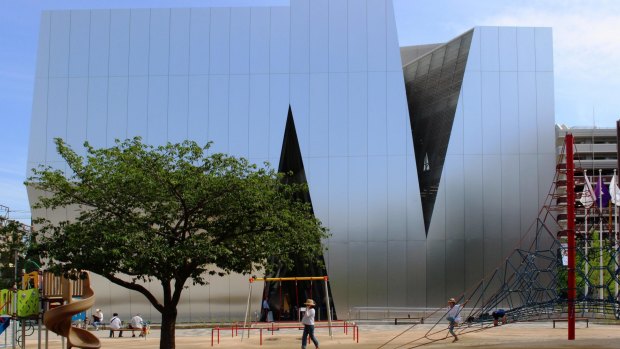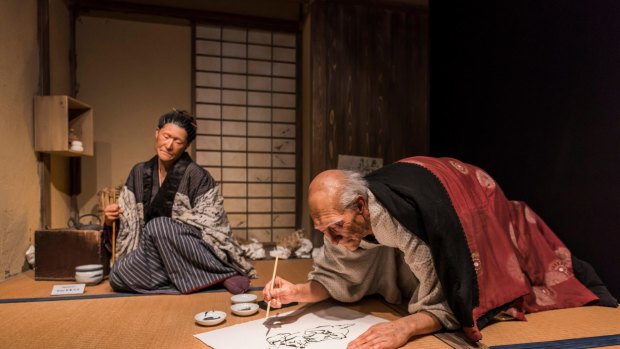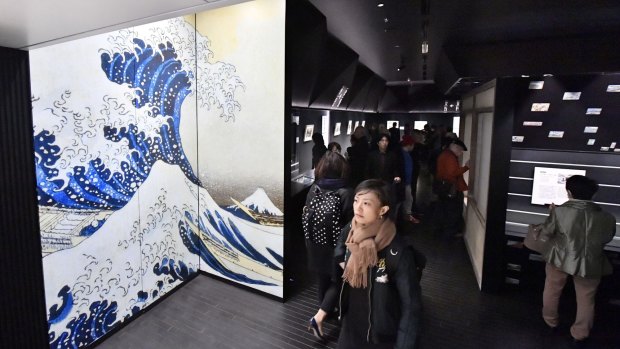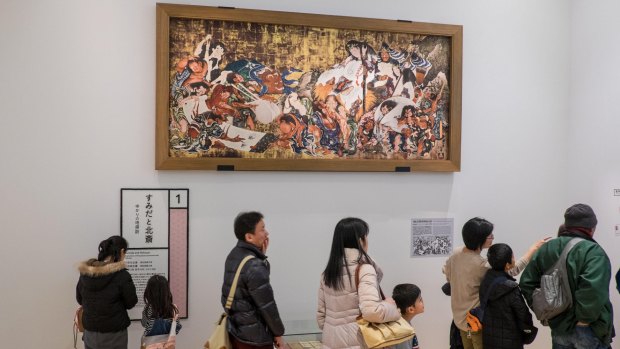This was published 6 years ago
Sumida Hokusai Museum, Tokyo, Japan: Where to see Japan's most famous artwork, The Great Wave
By Steve Meacham

The Kazuyo Sejima-designed Sumida Hokusai Museum which is located in central Tokyo.Credit: Alamy
Perhaps you don't recognise his name, Katsushika Hokusai. But you'll certainly recognise his most famous artwork.
The Great Wave off Kanagawa (also known simply as The Great Wave) is one of the most influential images in art history – parodied or adapted by countless painters and commercial artists. There's even a giant version of the Great Wave painted on the wall of one of my local surf shops in Sydney's Northern Beaches.
Today, however, I'm seeing the Great Wave in its original form – and I'm amazed how small it is. At 37cm wide by 25cm high, it's smaller than my computer screen, but somehow even more powerful witnessed up close.

A replica of Hokusai Katsushika and his daughter, Oi, at the Sumida Hokusai Museum.Credit: Alamy
Usually the eye concentrates on the immense force of the ocean, which – despite its two dimensional form – makes you feel you're about to be drenched, if not drowned.
Meanwhile Mount Fuji, in the background, seems minuscule and puny.
But this original woodcut print, approved by Hokusai, reveals things I've never noticed before.

The Sumida Hokusai Museum is dedicated to Katsushika Hokusai, a Japanese ukiyo-e artist best known for his work The Great Wave off Kanagawa.Credit: Alamy
It's not Mount Fuji that is being reduced to size by the forces of nature but human ambition.
Below the Great Wave, unseen in bad reproductions, lie three fishing boats which have failed to reach a safe harbour in time. Lord help those doomed fishermen as the Great Wave lurks above them.
Hokusai – born around 1760 – was in his late 60s when he produced his masterpiece. Thirty-Six Views of Mount Fuji was published in 1833 – a series of woodcuts which reverberated around the art world, particularly influencing the French impressionists.

Artworks of Katsushika Hokusai hang in the Sumida Hokusai Museum.Credit: Alamy
Now – at last – Tokyo has a dedicated museum/gallery devoted to Japan's most internationally renowned artist (yes, even more revered than Yoko Ono).
I'm visiting the Sumida Hokusai Museum, which opened in November 2016. Sumida is the riverside inner-city district of Japan's capital where Hokusai spent most of his long life (it's said he moved 90 times in his 90 years).
One of the museum's most popular exhibits is a diorama, showing an aged Hokusai on the floor of his squalid studio, bent over his latest creation in a lice-covered blanket.
His daughter, Katsushika Oi – a talented artist in her own right – is watching as he continues to work on yet another sublime illustration. Both are oblivious to the creative garbage which surrounds them. Hokusai died in 1849 when he was internationally renowned, but impoverished.
Architectural aficionados will relish the new museum, designed by award-winning Kazuyo Sejima.
The top floor is devoted to temporary exhibitions. On my visit it is devoted to The Seven Gods of Good Fortune – and the influence that the Japanese New Year theme of renewal and replenishment played on the work of Hokusai, his predecessors and successors.
On the next floor down, you arrive at the permanent Hokusai exhibition.
The Japanese will tell you that Hokusai was an adopted name: indeed he seems to have changed his name as often as he changed his abode.
But the quick version of his artistic career is that he began drawing and painting when he was six; had mastered woodblocks around 10 years later; became a pupil of Katsukawa Shunsho when he was a teenager; and suffered paralysis around the time he began his Thirty-Six Views of Mount Fuji (he made a full recovery with a self-concocted medicine he never patented).
On these two floors you'll see up to 1000 of Hokusai's works. They cover just about every aspect of 19th century Japanese art – including his notebooks filled with endless immaculate drawings; studies in calligraphy with his brush not leaving the page from whoa to go; and the incomparable woodcuts that made his name.
A year after the success of Thirty-Six Views of Mount Fuji, Hokusai published his "follow-up album": One Hundred Views of Mount Fuji.
Some regard the later work as his real masterpiece.
Either way, the Great Wave wasn't a one off.
If you've never seen his other 135 images of Mount Fuji (as I hadn't), do yourself a favour and catch that next wave.
TRIP NOTES
MORE
jnto.go.jp
STAYING THERE
Keio Plaza Hotel, in the heart of Shinjuku (one of Tokyo's most vibrant nightlife districts), is ideally placed on the rail/metro system for exploring greater Tokyo. See: keioplaza.com.
VISITING HERE
Sumida Hokusai Museum, hokusai-museum.jp/?lang=en.
The writer was a guest of Keio Plaza Hotel.
Sign up for the Traveller Deals newsletter
Get exclusive travel deals delivered straight to your inbox. Sign up now.